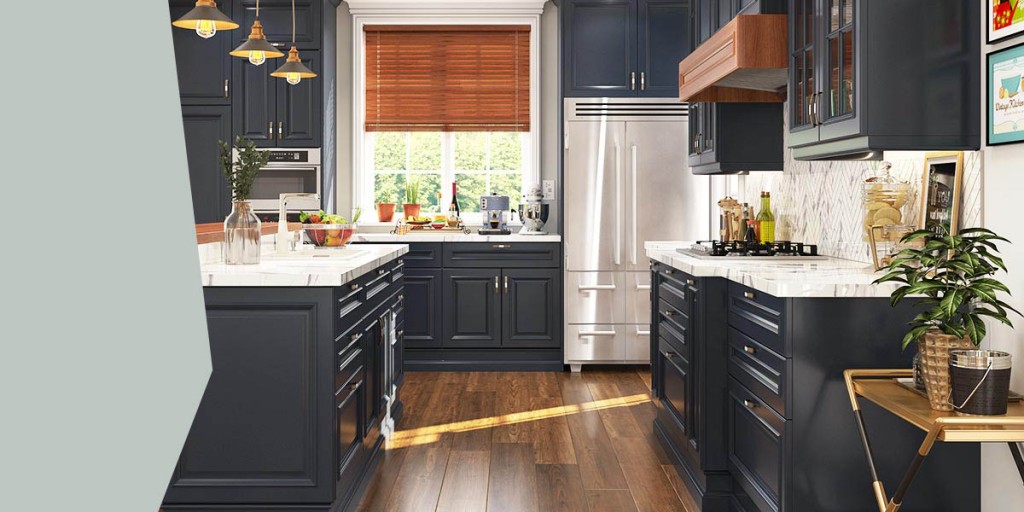
1. Determine how much you want to spend, and commit to it.
Setting a budget for your kitchen renovation project and committing to it sounds so simple, but without a proper budget it can be harder than you think.
The average cost of kitchen renovation depends on the size and quality of kitchen design you are looking for. Check out our blog here on typical renovation costs and fees or read our guide here to making a kitchen budget.
In Toronto, the average kitchen renovation project costs more than $80,000. However there are many factors that will help you determine whether you want or need to spend that much and a professional kitchen designer can help you with that determination.
2. Know the break down costs of a kitchen renovation.
Millwork and surface materials such as countertops and backsplashes consume the majority of a project budget. However it is not everything and knowing how to break down a kitchen project ensures a more accurate budget.
Here’s how it breaks down, on average:
35% cabinets
20% labor
20% appliances
10% tiles
5% fixtures
3% hardware
7% other
3. Set aside emergency funds to handle the unexpected.
Every design and renovation project encounters surprises. Working with a dedicated kitchen designer helps address those before the happen, and navigate you through them when they do happen. There are all sorts of budget-busting surprises that come up when managing a project alone, or when you give the design and planning work to a contractor. Leave some wiggle room in your renovation budget to cover surprises.
4. Make a list of priorities.
What’s most important to you? Quality manufacturing? Good design? Eco-Friendly materials? Work with your kitchen designer and list out project priorities so if unexpected costs hit your budget, you’ll still get the top things on your list done.
5. Know the details of how you will pay for this project.
There are many ways to benefit from a home renovation. Canadian and Ontario home renovation tax credits award homeowners a tax credit for eligible renovation costs. Some of these credits are non-refundable, so the tax credit can only be used to reduce taxes owing in the current taxation year.
Home equity loans are popular because they’re tax deductible so even if you have cash in hand, borrowing money at a low interest rate may be the best option.
If you’re getting a loan, factor in costs like interest and loan origination fees. Also, find out when you’ll get the funding from your loan. You’ll need to make deposits with your contractors, and you’ll need to pay for materials up front. You can learn more about the renovation process in our post breaking down the kitchen renovation process from start to finish.
6. Plan where you’re going to stay and prepare food during construction.
Living someplace else while the work is being done is a good idea and will lessen your stress. Take into account the cost of an apartment or hotel, storage fees and moving fees.
If you stay, there will be a cost to your sanity. You could also set up a temporary kitchen in an adjacent room, and you should add in the cost of doing this.
7. Factor in the cost of eating out.
Face it, you will be eating a lot of meals in restaurants or bringing home take-out food while your kitchen is torn up. Fit this expense into your budget at the outset.
8. Create a spreadsheet for your budget and check it often.
Put your budget and how much you’re actually spending on spreadsheets so you can keep tabs on how much you are actually spending. If you see a cost overrun starting to happen, you can stop it.
9. Do some of the small work to lower your costs.
You don’t have to pay someone else to do all the work. Demolition – taking out the old cabinets, appliances and flooring – is easy to do.
10. Avoid extras. Don’t be tempted to deviate from your budget mid-project.
If you catch yourself saying “It would be so great if we added (fabulous kitchen feature here),” stop yourself. This is how budgets get blown. Go look at that remodeling budget you made in step 1, and repeat the number like a mantra. You can live without the little extras.

I really like it good work 🙂
LikeLike
Thanks Stone Cut, we love your work too. Keep posted as we have awesome new interesting things happening.
LikeLike